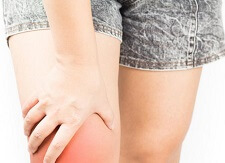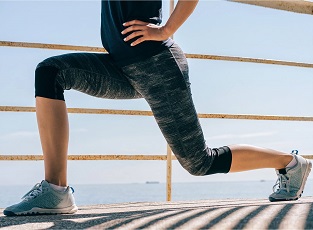- Home
- Knee Pain Treatment
- Tubigrip
Tubigrip Compression Bandage
Written By: Chloe Wilson, BSc(Hons) Physiotherapy
Reviewed by: KPE Medical Review Board
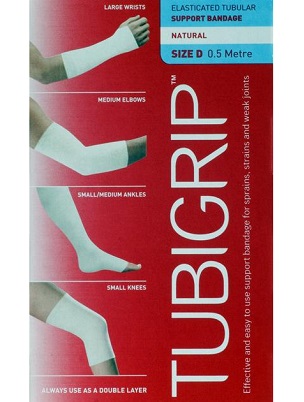
Tubigrip is a specially designed, elasticated tubular bandage that provides firm but comfortable support for sprains, strains and weak joints.
It is one of the best ways to provide support and reduce swelling after injuries, and can be used to help reduce persistent swelling. It can also be used to keep dressings in place.
The benefits of it over other bandages are that it is easy to apply (just pull it on), it stays in place all day without the need for pins or tape and it is reusable and easy to wash.
We will start be answering some of the most frequently asked questions about Tubigrip including how to use it safely and easily and will then look in more detail about how it actually works to reduce swelling and provide support and how to use it most effectively.
Frequently Asked Questions
Let's have a look at the most frequently asked questions about tubigrip compression bandages, how they work and how to use them correctly.
1. How Does Tubigrip Work?
Tubigrip is made up of small elastic threads covered in fabric. This allows it to mold to each individuals shape whilst remaining firmly in place.
It distributes pressure evenly over the area exerting a pressure of 10-20 mm Hg to the limb (when worn double thickness) which helps to reduce swelling.
2. How Does It Feel?
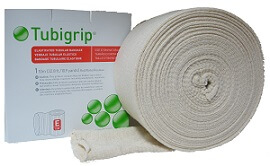
Tubigrip is very comfortable to wear. It provides gentle support without feeling tight, so it doesn’t limit movement at all.
Also it doesn’t get itchy and doesn’t usually fall down - but if it does, we've got some top tips on how to stop that!
3. What Size Tubigrip Do I Need?
Tubgrip sizes vary from A (smallest) to L (largest). The correct size will depend on which body part you are using it on, and your body shape.
See our Tubigrip Sizes Guide to identify what size is right for you.
4. How Expensive Is It?
Prices of tubigrip compression bandage vary depending on size, length and colour. A small width and length piece can cost as little as $10/£3 but it is often more cost effective in the long run to buy a long 10m roll than multiple shorter lengths.
You can compare Tubigrip prices and purchase Tubigrip using these links.
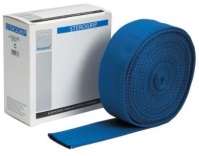
5. Is Tubigrip Reusable?
Yes! You can use it again and again. Eventually over time it may start to fray and need replacing but it usually lasts a good few weeks to months as long as you wash it!
6. How Do I Wash Tubigrip?
Tubigrip can be hand washed in warm soapy water and then line dried. It can help to have a spare so you can alternate between the two when you need to wash one.
7. What Options Are Available?
Tubigrip comes in 0.5m, 1.0m or 10m rolls, and in creamy beige, natural flesh colour or blue depending on what country you are in – you can find out more about what options are available in our Tubigrip Sizes & Prices Guide.
8. What Is It Made From?
Tubigrip is made from cotton, elastodiene and polyester. Please note that most brands contain natural rubber latex, but there are some available that do not.
9. Can I Wear Tubigrip At Night?
Tubigrip must NOT be worn in bed as it can reduce the circulation in the leg if you aren’t moving around, which could lead to a blood clot. It can also roll down and become uncomfortable.
10. Should You Wear It When Exercising?
You can wear tubgrip when exercising for support, but bear in mind our muscles should be able to provide all the support we need. If your knee is feeling weak, carry out knee strengthening exercises daily without wearing the compression bandage and as the muscles get stronger, you should be able to wean off wearing it for more strenuous exercise.
If you keep using Tubigrip compression bandages long term, it can lead to muscles becoming weaker because they don’t think they have to work as the tubigrip is doing their job. This will likely result in longer term knee problems.
11. How Do I Put Tubigrip On?
Tubigrip is really easy to apply. It should be worn double thickness and run from the joint above to the joint below.
We have put together a page on how to apply Tubigrip including top tips on how to get it on easily and keep it in place, as well as how to choose the right size for you.
How Does Tubigrip Work?
Tubigrip is really useful following knee injuries or surgery as it:
1. Reduces Swelling
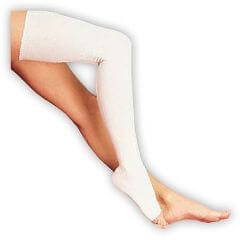
With any injury, there is often swelling. Although some swelling is
inevitable, too much swelling results in significant loss of function,
excessive pain and eventually reduces the blood flow through vessel
restriction. This slows the healing process and can be painful.
The most effective way to apply and maintain compression on the knee is to use a tubular compression bandage rather than a firm plastic bandage (such as zinc-oxide tape). Usage of a tight, non-elastic bandage will result in reduction of adequate blood flow, potentially causing ischemia.
Another way to reduce swelling is to use ice. Visit the ice treatment section to find out more about how to use ice safely and effectively to reduce swelling.
2. Provides Support
Tubigrip can be used to help support a weak and painful knee. It is most useful in the first few days after an injury. It is important to wean off the support of the tubigrip compression bandage as soon as possible, certainly within a week, otherwise muscles are likely to get weaker due to not being used.
NB it is ok to wear it for longer if you are using it to reduce swelling rather than to provide support.
How to Use it Effectively
Tubigrip should always run from the just below the joint above where the injury is to just above the joint below e.g. if treating the knee it should go from the top of the thigh to the ankle.
It should always be worn double thickness. The simplest way to do this is by folding over a single piece, rather than using two separate pieces. Visit the How to Use section for diagrams and top tips on how to apply it including how to stop it from rolling down and how to find the right size for you.
It can be worn throughout the day, but should be removed when carrying out any rehab exercises to allow the muscles to get stronger.
Safety Advice: DO NOT wear tubigrip at night as it may end up exerting too high a pressure on the area, reducing circulation.
If you want to buy some, you can find the best prices for the full range of widths, lengths and colours in our Where Can You Buy Tubigrip guide.
What Else Can Help?
Tubigrip is the easiest way to apply compression following an injury as part of PRICE treatment (Protect, Rest, Ice, Compress, Elevate). PRICE is usually the first line treatment for any injury and using it can help to reduce pain, speed up healing and prevent any further damage. Find out more about how to effectively use it in the PRICE treatment section.
There’s lots more information on treating knee pain to discover such as strengthening exercises, knee stretches and if all else fails surgery. If you want some help working out what is causing your pain visit the knee pain diagnosis section.
You may also be interested in the following articles:
Page Last Updated: 28/11/23
Next Review Due: 28/11/25
